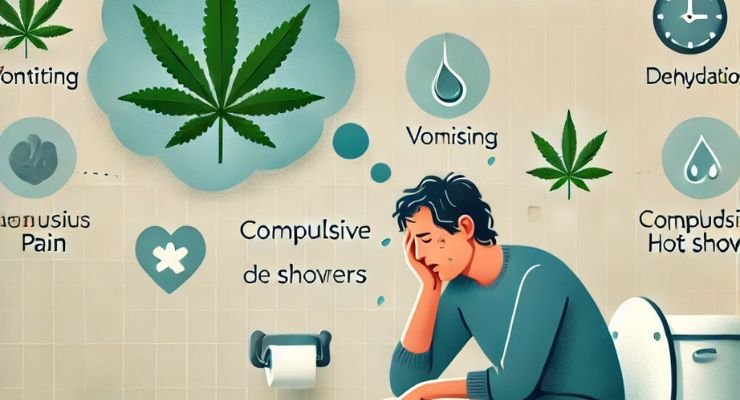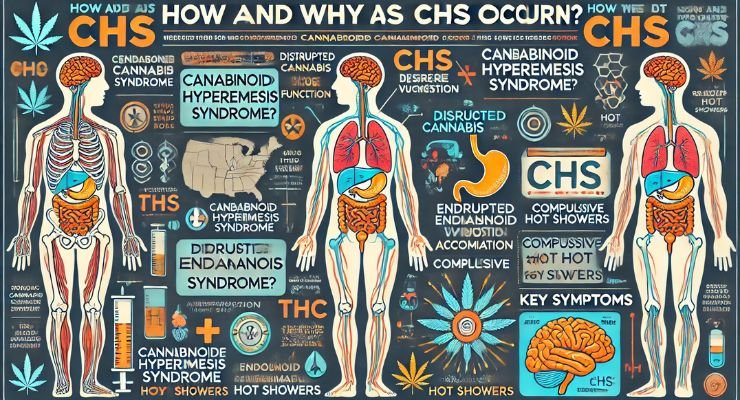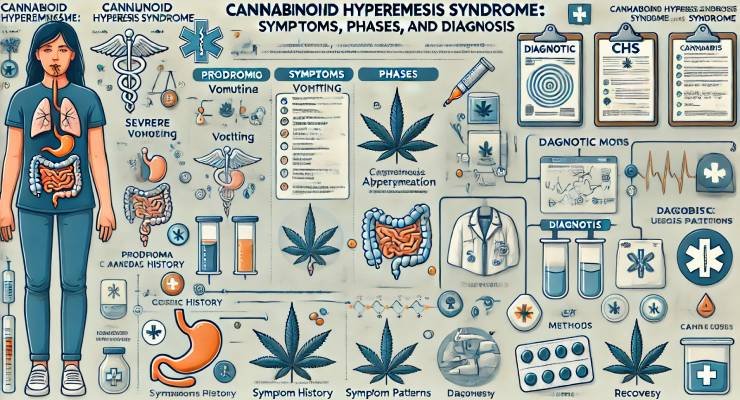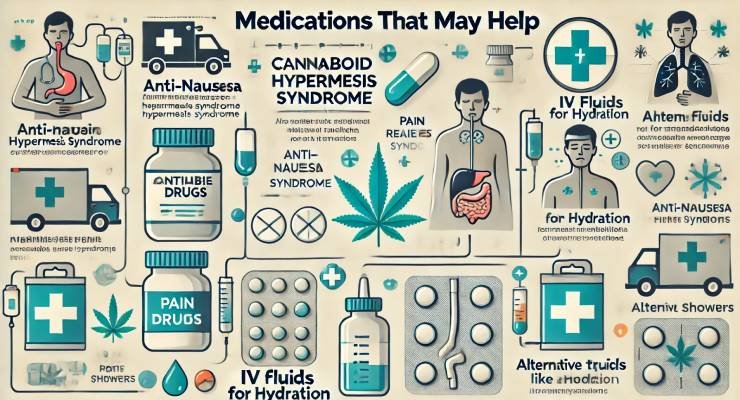
Cannabinoid Hyperemesis Syndrome (CHS) is a condition that affects some long-term, heavy cannabis users, causing repeated episodes of nausea, vomiting, and abdominal pain. First identified in medical literature in the early 2000s, CHS remains a relatively new and poorly understood condition.
In recent years, CHS has gained attention as more cannabis users report experiencing unexplained nausea and vomiting, leading to emergency room visits. With cannabis becoming increasingly legal and accessible, awareness of CHS is growing among both users and healthcare professionals.
The symptoms of CHS can be severe, often disrupting daily life and causing dehydration or weight loss. Many affected individuals struggle to find relief, as traditional anti-nausea treatments are often ineffective. This article will explore CHS, its symptoms, potential causes, and its impact on those who experience it.
What Is Cannabinoid Hyperemesis Syndrome (CHS)?
CHS is a condition linked to long-term cannabis use. It is characterized by recurrent episodes of intense nausea, vomiting, and abdominal pain. While cannabis is often used for its anti-nausea effects—especially for chemotherapy patients. CHS presents a paradox: instead of preventing nausea, chronic cannabis use in some individuals leads to persistent vomiting.
Although first identified in 2004, CHS remains underdiagnosed because its symptoms resemble those of other digestive disorders. Many patients go through extensive medical tests before doctors recognize CHS as the cause of their symptoms. The only proven treatment for CHS is completely stopping cannabis use, which typically results in a full recovery.
How and Why Does CHS Occur?

CHS occurs due to prolonged and heavy cannabis use, which disrupts the body’s endocannabinoid system (ECS). While THC initially has anti-nausea effects, chronic exposure is believed to overstimulate CB1 receptors in the brain and digestive system, leading to paradoxical symptoms like severe nausea, vomiting, and abdominal pain. The exact cause isn’t fully understood, but researchers suggest that long-term cannabis use may lead to receptor desensitization, affecting how the body regulates nausea and digestion.
How Chronic Cannabis Use May Lead to CHS
Initially, cannabis may relieve nausea, but prolonged exposure to cannabinoids can overstimulate the ECS, disrupting the body’s natural balance. Researchers suggest that chronic THC exposure interferes with the body’s normal vomiting regulation, which eventually triggers the symptoms of CHS.
Recognizing CHS Symptoms
The symptoms of CHS tend to occur in cycles:
1. Prodromal Phase: Patients experience mild nausea, anxiety, and morning discomfort but continue using cannabis, often believing it helps.
2. Hyperemetic Phase: Severe nausea, repeated vomiting, and abdominal pain occur. Many patients find relief in hot showers or baths, which may temporarily ease symptoms. Dehydration from frequent vomiting can lead to hospitalization.
3. Recovery Phase: Once cannabis use stops, symptoms gradually disappear, and normal digestion resumes. However, if cannabis use resumes, symptoms often return.
The Importance of Awareness and Research
CHS is still not widely recognized, and many cannabis users may not be aware of its risks. Increased research is needed to fully understand why certain individuals develop CHS while others do not. Awareness among both healthcare providers and cannabis users is essential for proper diagnosis and treatment.
For those experiencing unexplained nausea and vomiting, considering cannabis use as a potential cause is crucial. Recognizing the symptoms early and quitting cannabis use entirely is the most effective way to recover from CHS.
By understanding CHS and spreading awareness, we can help ensure cannabis users make informed decisions about their health.
Cannabinoid Hyperemesis Syndrome (CHS): Symptoms, Phases, and Diagnosis

Cannabis use can have short-term effects like dry mouth, dizziness, and nausea, which usually go away in a few hours. However, heavy and long-term cannabis use can lead to a more serious condition called Cannabinoid Hyperemesis Syndrome (CHS).
Many people don’t realize they have CHS at first. The symptoms—such as nausea and vomiting—are often mistaken for food poisoning, stomach flu, or another digestive issue.
Symptoms and Stages of CHS
CHS develops in three stages: the prodromal phase, the hyperemesis phase, and the recovery phase.
1. Prodromal Phase (Early Warning Stage)
This phase can last for months or even years before CHS fully develops. Symptoms include:
- Mild nausea, often worse in the morning
- Loss of appetite
- Stomach discomfort and anxiety
- A belief that using more cannabis helps relieve nausea
Since the symptoms are mild and come and go, most people don’t recognize this as CHS. In fact, many increase their cannabis use, thinking it will help, but this only makes the condition worse over time.
2. Hyperemesis Phase (Severe Vomiting Stage)
This is the most intense and recognizable stage of CHS, with:
- Persistent nausea and uncontrollable vomiting in cycles
- Severe stomach pain
- Extreme dehydration from constant vomiting
- Temporary relief from taking hot showers or baths
People in this stage often end up in emergency rooms due to dehydration and imbalanced electrolytes. Standard anti-nausea medications don’t work well.
3. Recovery Phase
Once cannabis use is completely stopped:
- Nausea and vomiting gradually disappear
- Appetite returns to normal
- The body recovers from dehydration and malnourishment
Recovery happens only if cannabis use is completely discontinued. If cannabis is used again, symptoms can return.
How Is CHS Diagnosed?
There is no single test to confirm CHS. Doctors diagnose it by looking at:
1. Medical History
Doctors ask about cannabis use, including how long and how often someone has been using it. Keeping a record of nausea and vomiting episodes helps identify patterns. Many people don’t immediately think cannabis is causing their symptoms, so being honest about usage is important.
2. Recognizing Symptoms
CHS has a unique pattern: repeated vomiting, ongoing nausea, and stomach pain that improves after stopping cannabis. A key sign is that hot showers or baths provide temporary relief. This three-phase cycle (prodromal, hyperemesis, recovery) helps doctors distinguish CHS from other stomach issues.
3. Ruling Out Other Conditions
CHS symptoms are similar to other digestive disorders, so doctors need to rule out conditions like:
- Cyclic Vomiting Syndrome (CVS): Also causes repeated vomiting but isn’t linked to cannabis use.
- Gastroparesis: Slows stomach emptying, leading to nausea and vomiting.
- Infections: Usually caused by bacteria or viruses, which tests can confirm.
Since CHS isn’t widely recognized, many doctors misdiagnose it at first. Patients often undergo multiple tests—such as blood work, imaging scans, and endoscopies—before CHS is confirmed.
Management and Treatment of CHS
Hot Showers and Baths: Many people with CHS find relief from hot showers. Heat activates certain nerve receptors in the skin that help reduce nausea. It may also help with pain and vomiting signals. Some take multiple hot showers daily for temporary relief. However, too many hot showers can dry out and irritate the skin. While this method can help in the short term, it is not a cure and does not replace medical treatment or quitting cannabis.
Fluids and Electrolytes: Frequent vomiting can lead to dehydration and loss of important minerals like sodium and potassium. Staying hydrated is crucial to protect your organs, especially your kidneys. Mild cases can be managed with sports drinks, coconut water, or electrolyte solutions. Severe cases may require hospitalization to receive IV fluids. It’s best to drink small sips of fluids frequently instead of large amounts all at once.
Completely Stop Using Cannabis: Continuing to use cannabis keeps the cycle going. The only way to fully recover is to stop using it entirely. Even a small amount can trigger nausea and vomiting again. Many people only find lasting relief after quitting completely, as gradual reduction often doesn’t work. Getting medical support or counseling can help with quitting. It’s also important to understand how cannabis use is connected to CHS to avoid relapse in the future.
Long-Term Treatment: Total Cessation of Cannabis
The only known cure for CHS is to completely stop using cannabis. Once a person quits, their symptoms usually go away within a few days to weeks. However, if they start using cannabis again, the symptoms often return, sometimes just as severely as before.
The withdrawal phase can be challenging and may include cravings, mood swings, and trouble sleeping. These symptoms can be uncomfortable but tend to fade over time. Having support during this period is important. Joining a support group or seeking medical guidance can help make the process easier and increase the chances of quitting successfully.
To stay on track and avoid relapse, it’s helpful to recognize personal triggers and make necessary lifestyle changes. Developing healthy habits, finding new ways to manage stress, and surrounding oneself with supportive people can all contribute to long-term recovery.
Medications That May Help

- The best way to treat CHS (Cannabinoid Hyperemesis Syndrome) is to stop using cannabis. Some medications can help with withdrawal symptoms, but they may not fully stop the vomiting.
- Medications for nausea and vomiting (Antiemetics – Ondansetron, Metoclopramide): Doctors often prescribe these to help with nausea and vomiting, but they don’t always work well for CHS patients. Many people keep feeling sick even after taking these medications, which leads to repeated hospital visits. Because of this, doctors may suggest other treatments, but quitting cannabis is the most effective solution. It’s important to understand this so that expectations for treatment are realistic.
- Pain relief (Acetaminophen, NSAIDs): Pain relievers are sometimes given to help with stomach pain caused by CHS. They may work for some people, but their effectiveness depends on how bad the symptoms are. Other methods, like taking hot showers, can sometimes provide better relief than pain medications. NSAIDs should not be used too often, as they can cause stomach problems. Before using pain relievers regularly, it’s best to talk to a doctor. Capsaicin cream is another option to consider.
- Capsaicin cream: This cream contains capsaicin, the active ingredient in chili peppers, which affects nerve receptors that control nausea. It works by calming the TRPV1 receptor, which plays a role in pain and temperature control. When applied to the stomach or other affected areas, capsaicin cream may provide short-term relief from nausea and pain. Some patients find it helpful, but results vary depending on the product. It’s important to be careful when using it, as it can cause a burning sensation and skin irritation. Always follow the directions to avoid discomfort.
- Other important treatments: People with CHS often need fluids and electrolytes to prevent dehydration from excessive vomiting. The best approach is to work with a doctor to find the most effective way to manage symptoms.
Prevention and Awareness
Helping Cannabis Users Learn About CHS
Many people who use cannabis often don’t know about Cannabinoid Hyperemesis Syndrome (CHS). This condition mostly affects those who smoke cannabis every day for many years. Because of a lack of awareness and wrong information, it can take a long time to get the right diagnosis and treatment.
To prevent this, efforts should be made to spread awareness in hospitals, cannabis stores, and on the internet. If people recognize CHS symptoms early, they can avoid unnecessary medical treatments and long periods of suffering. More studies and education are needed so that cannabis users can make well-informed choices about their health.
Understanding Your Limits and Usage Habits
Not everyone who uses cannabis will get CHS, but it is important to know your limits and how often you use it. Early warning signs include feeling sick in the morning or having stomach problems. If these signs appear often, cutting down or stopping cannabis use might help.
Keeping a symptom diary can help track patterns and make it easier to see if CHS might be the cause. If symptoms continue, it’s best to talk to a doctor who can guide you on what to do next. Catching CHS early can prevent serious health problems.
When to Get Medical Help
You should see a doctor if you have ongoing nausea and vomiting, especially if you use cannabis regularly. CHS can cause serious problems like dehydration, lack of important body salts, kidney issues, and poor nutrition.
Doctors can provide fluids through an IV, give medicine, and advise on managing symptoms. If CHS is recognized early and cannabis use is stopped, hospital visits can be avoided, and recovery will be much easier. Taking action early can help prevent future episodes and improve overall health.
Conclusion
Cannabinoid Hyperemesis Syndrome (CHS) is a serious condition that many cannabis users don’t recognize until symptoms become severe. It causes ongoing nausea, vomiting, and stomach pain, often leading to dehydration and hospital visits. Recognizing CHS early is important, as stopping cannabis use is the only proven way to relieve symptoms.
As cannabis use becomes more common, more research is needed to understand CHS and why it affects some users but not others. Increased awareness can help doctors diagnose the condition faster and provide better guidance for those affected.
For cannabis users, responsible consumption and paying attention to any unusual symptoms are key. Understanding CHS can help prevent unnecessary suffering and promote safer use.
By staying informed and making mindful choices, individuals can reduce their risk of CHS and protect their health. Awareness and education are essential in ensuring cannabis is used safely and responsibly.
Frequently Asked Questions
CHS is caused by long-term, frequent cannabis use, especially high-THC strains. Over time, cannabis can interfere with the body’s endocannabinoid system, leading to cycles of nausea, vomiting, and abdominal pain. The exact mechanism is unclear, but it likely involves how THC affects digestion, the brain, and temperature regulation.
CHS symptoms include severe nausea, repeated vomiting, and intense stomach pain. Many individuals experience dehydration due to excessive vomiting, leading to dizziness and fatigue. Symptoms come in cycles and can last for hours or days. A distinguishing feature is temporary symptom relief with hot showers or baths, which can help regulate the body’s temperature response.
The most effective treatment for CHS is stopping cannabis use completely. In the short term, medical care may involve IV fluids, anti-nausea medications, and electrolyte replacement to manage dehydration. Hot showers or baths can provide temporary relief. If cannabis use continues, symptoms often return, making cessation the only long-term solution for preventing future episodes.
Symptoms can last for several hours to days, depending on cannabis use and individual factors. Acute episodes of nausea and vomiting may persist for days but typically improve once cannabis is stopped. Recovery varies, with some individuals experiencing lingering stomach discomfort for weeks. Completely stopping cannabis use is the key to long-term symptom relief.
Hot showers or baths temporarily relieve CHS symptoms by affecting how the body’s temperature regulation system interacts with the endocannabinoid system. Heat may desensitize pain receptors and provide comfort by redirecting sensory focus. However, this is only a temporary fix, and symptoms will return until cannabis use is fully discontinued.
Yes, if left untreated, CHS can lead to severe dehydration, electrolyte imbalances, and kidney damage due to prolonged vomiting. In extreme cases, complications like acute kidney injury or irregular heart rhythms can occur. Seeking medical attention for IV fluids and supportive care is crucial. The only way to prevent recurrence is to stop using cannabis completely.

